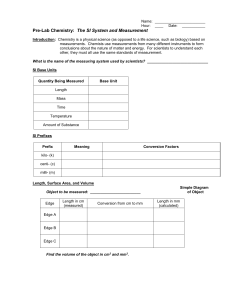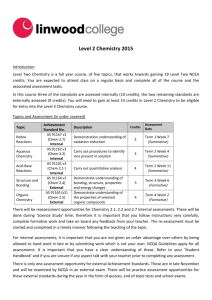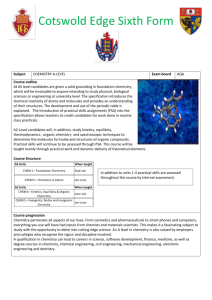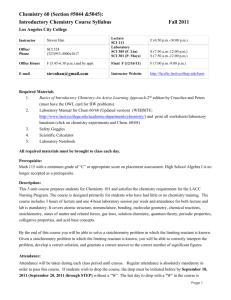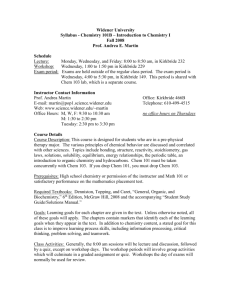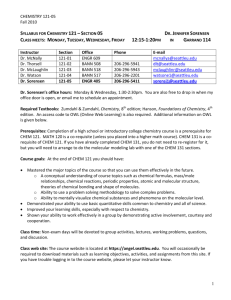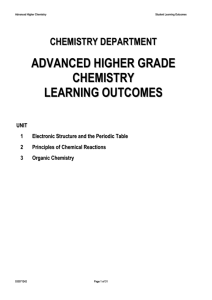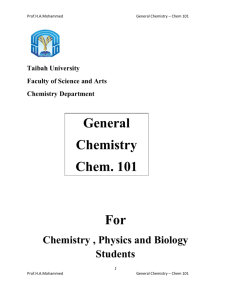CHEM& 161 - Big Bend Community College
advertisement
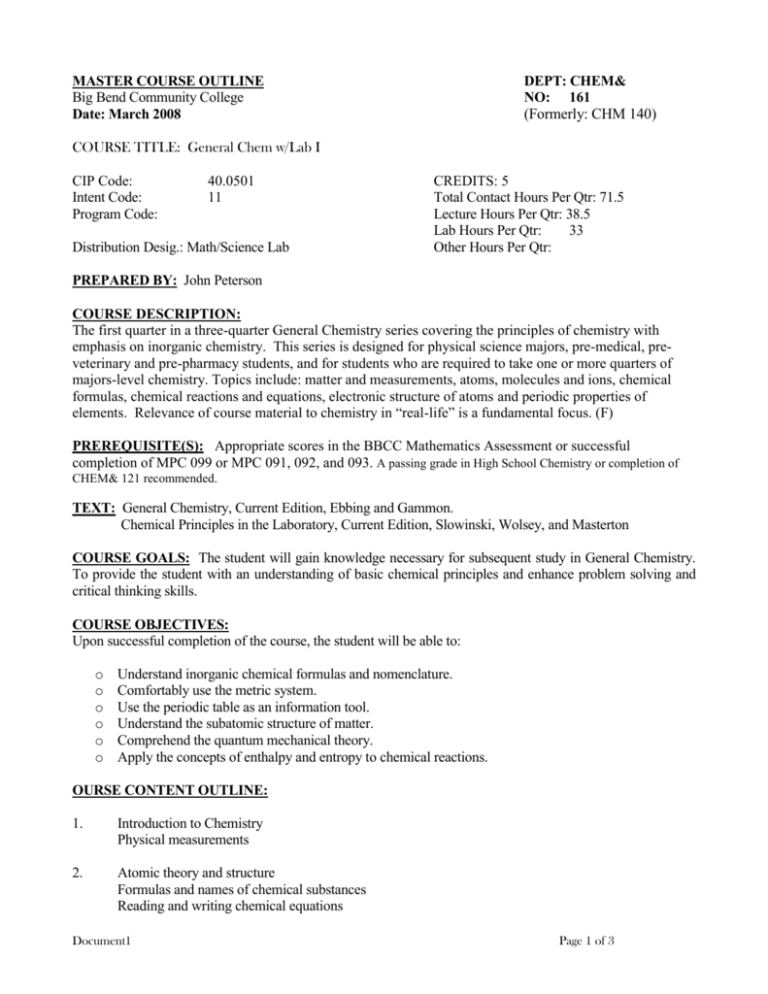
MASTER COURSE OUTLINE Big Bend Community College Date: March 2008 DEPT: CHEM& NO: 161 (Formerly: CHM 140) COURSE TITLE: General Chem w/Lab I CIP Code: Intent Code: Program Code: 40.0501 11 Distribution Desig.: Math/Science Lab CREDITS: 5 Total Contact Hours Per Qtr: 71.5 Lecture Hours Per Qtr: 38.5 Lab Hours Per Qtr: 33 Other Hours Per Qtr: PREPARED BY: John Peterson COURSE DESCRIPTION: The first quarter in a three-quarter General Chemistry series covering the principles of chemistry with emphasis on inorganic chemistry. This series is designed for physical science majors, pre-medical, preveterinary and pre-pharmacy students, and for students who are required to take one or more quarters of majors-level chemistry. Topics include: matter and measurements, atoms, molecules and ions, chemical formulas, chemical reactions and equations, electronic structure of atoms and periodic properties of elements. Relevance of course material to chemistry in “real-life” is a fundamental focus. (F) PREREQUISITE(S): Appropriate scores in the BBCC Mathematics Assessment or successful completion of MPC 099 or MPC 091, 092, and 093. A passing grade in High School Chemistry or completion of CHEM& 121 recommended. TEXT: General Chemistry, Current Edition, Ebbing and Gammon. Chemical Principles in the Laboratory, Current Edition, Slowinski, Wolsey, and Masterton COURSE GOALS: The student will gain knowledge necessary for subsequent study in General Chemistry. To provide the student with an understanding of basic chemical principles and enhance problem solving and critical thinking skills. COURSE OBJECTIVES: Upon successful completion of the course, the student will be able to: o o o o o o Understand inorganic chemical formulas and nomenclature. Comfortably use the metric system. Use the periodic table as an information tool. Understand the subatomic structure of matter. Comprehend the quantum mechanical theory. Apply the concepts of enthalpy and entropy to chemical reactions. OURSE CONTENT OUTLINE: 1. Introduction to Chemistry Physical measurements 2. Atomic theory and structure Formulas and names of chemical substances Reading and writing chemical equations Document1 Page 1 of 3 3. The mole concept Determination of chemical formulas from percent composition Stoichiometry 4. Behavior of ions in aqueous solutions Solution concentrations Classes of reactions Quantitative analysis 5. Heats of reaction Enthalpy and entropy Applying concepts of themochemistry to chemical equations 6. The wave nature of light The Bohr Theory and photons Quantum mechanics 7. Electronic structure of atoms Periodicity of the elements EVALUATION METHODS/GRADING PROCEDURES: Evaluation will be accomplished by examination, quizzes and laboratory performance and write up. The final grade will be based on a percentage of the total points possible: A typical breakdown of the points is: Three unit exams comprise approximately 45% of the total score, the final exam approximately 24%, laboratories approximately 24%, quizzes and homework provide the balance of the points. The grading scale is as follows: Above Below 95% = 4.0 85% = 3.0 72% = 2.0 60% = 1.0 55% = 0.7 55% = 0.0 PASSING GRADE: A GRADE OF 55% or higher MUST be obtained in both the LECTURE and the LABORATORY portions of this course. A grade below 55% will result in a grade of 0.0 for CHEM 105. ATTENDANCE: Attendance is highly recommended. Make-up exams are permitted only for verifiable medical reasons and these exams are always more difficult than the original exam. It is the responsibility of the student to obtain copies of all hand-outs and to know what happened during a missed class. Missing a class is not a valid excuse for turning in late work. If you know you will miss a class, turn the work in early or send it with another student in the class. The student is expected to stay current with all assignments (reading and others) as these assignments will be the basis of class discussions and group work. Document1 Page 2 of 3 PLANNED TEACHING METHODS/LEARNING STRATEGIES: x Lecture Small Group Discussion x Laboratory Audiovisual Supervised Clinical Individualized Instruction Special Project Other (List) SPECIAL EQUIPMENT/FACILITIES/MATERIALS/SUPPLIES REQUIRES: Safety Goggles _______ Division Chair Approval Document1 Page 3 of 3



